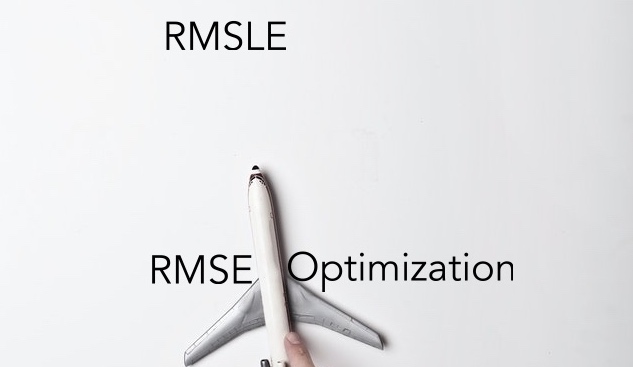Original photo by Andrea Piacquadio from Pexels
What’s the problem?
Sometimes, RMSE(Root Mean Squared Error) isn’t the best metric to solve your problem, so you decided to use RMSLE (Root Mean Square Logarithmic Error), or the competition you participate in are using RMSLE instead of the usual RMSE for judging criteria.
Some sophisticated libraries such as TensorFlow give the option to optimize RMSLE directly, but most of the machine learning libraries out there don’t support RMSLE optimization directly, but only for RMSE or MSE
in hurry for the trick? jump here
RMSE vs RMSLE
Let’s take a quick recap about the difference between these metric


By logarithmic property, RMSLE can be written as :

By seeing this form, you should get that RMSLE focus on ratio between the actual value and the prediction value.
Prediction = 10 with Actual = 100 gives roughly the same RMSLE with Prediction = 100 with Actual = 1000.
Also, RMSLE are not symetric across the actual value. If we have actual value 500, prediction = 0 give higher RMSLE than prediction = 1000 (even tough both have distance 500 from actual value).
Because of these properties, intuitively minimizing RMSE ≠ minimizing RMSLE.
Trick for optimizing RMSLE trough RMSE
If your machine learning libraries only support RMSE/MSE optimization while what you need is RMSLE optimization, then the trick is to transform your target variable so it share the same form as RMSLE.

You model the data using z as target instead of y. After getting the prediction, revert back the result with simple transformation

Here’s the detail :
- Do your EDA and feature engineering like usual
- Transform the target variable into z = log(y+1)
- Build machine learning model that optimized for RMSE/MSE to predict z
- Transform your prediction result into y = exp(z) – 1
Why this trick would works
I don’t have any rigorous proof about why this trick works, but I can give some intuitive explanation why this works.





Experimentation
I will use Python and R to demonstrate the technique into 2 different dataset.
For the first one I will use R & Caret to model Bike Sharing Data. I use caret because it able to automatically do hyperparameter tuning for my xgboost model.
library(caret)
library(lubridate)
library(MLmetrics)
data = read.csv("train.csv")
#Simple feature engineering
data$datetime = ymd_hms(data$datetime)
data$hour = hour(data$datetime)
data$day = wday(data$datetime)
data$year = year(data$datetime)
#Split the data into train and test set
train = data[0:9000,]
test = data[9000:nrow(data),]
#Define what variables we would use as predictor and respone
prediction_formula = formula(count~season+workingday+weather+temp+humidity+windspeed+hour+day+year)
#WITHOUT RMSLE TRICK
#Use 5-folds cross validation during hyperparam optimization
fitControl <- trainControl(method = "cv",number = 5)
model.cv <- train(prediction_formula,
data = train,
method = "xgbTree", #use xgboost
trControl = fitControl)
prediction = predict(model.cv,test)
#Convert negative prediction into 0
prediction = ifelse(prediction<0,0,prediction)
RMSLE(prediction,test$count)
> 0.6929696
#WITH RMSLE TRICK
#Transform the target variable
train$count = log(train$count+1)
model.cv <- train(prediction_formula,
data = train,
method = "xgbTree",
trControl = fitControl)
prediction = predict(model.cv,test)
#Revert the prediction to the original scale
prediction = exp(prediction)-1
prediction = ifelse(prediction<0,0,prediction)
RMSLE(prediction,test$count)
> 0.3510241
The RMSLE on the test data significantly improve from 0.69 into 0.35 after applying this technique.
For the second experiment, I use Python and PyCaret on Insurance Medical Dataset
#Without RMSLE trick
from pycaret.datasets import get_data
from sklearn.model_selection import train_test_split
from sklearn.metrics import mean_squared_log_error as MSLE
import numpy as np
from pycaret.regression import *
data = get_data('insurance')
train,test = train_test_split(data,train_size=0.75,random_state=2233)
reg1 = setup(train, target = 'charges', session_id=123, log_experiment=True, experiment_name='insurance1')
best_model = compare_models(fold=5)
predict_new = predict_model(best_model, data=test)
np.sqrt(MSLE(predict_new.Label,test.charges))
>> 0.43920470684686724
#With RMSLE trick
from pycaret.datasets import get_data
from sklearn.model_selection import train_test_split
from sklearn.metrics import mean_squared_log_error as MSLE
import numpy as np
from pycaret.regression import *
data = get_data('insurance');
train,test = train_test_split(data,train_size=0.75,random_state=2233)
train.charges = np.log(train.charges+1)
reg2 = setup(train, target = 'charges', session_id=123, log_experiment=True, experiment_name='insurance2')
best_model = compare_models(fold=5)
predict_new = predict_model(best_model, data=test)
predict_new.Label = np.exp(predict_new.Label)-1
np.sqrt(MSLE(predict_new.Label,test.charges))
>> 0.4318665993748389
By using PyCaret, the RMSLE decrease from 0.43920 to 0.43186

